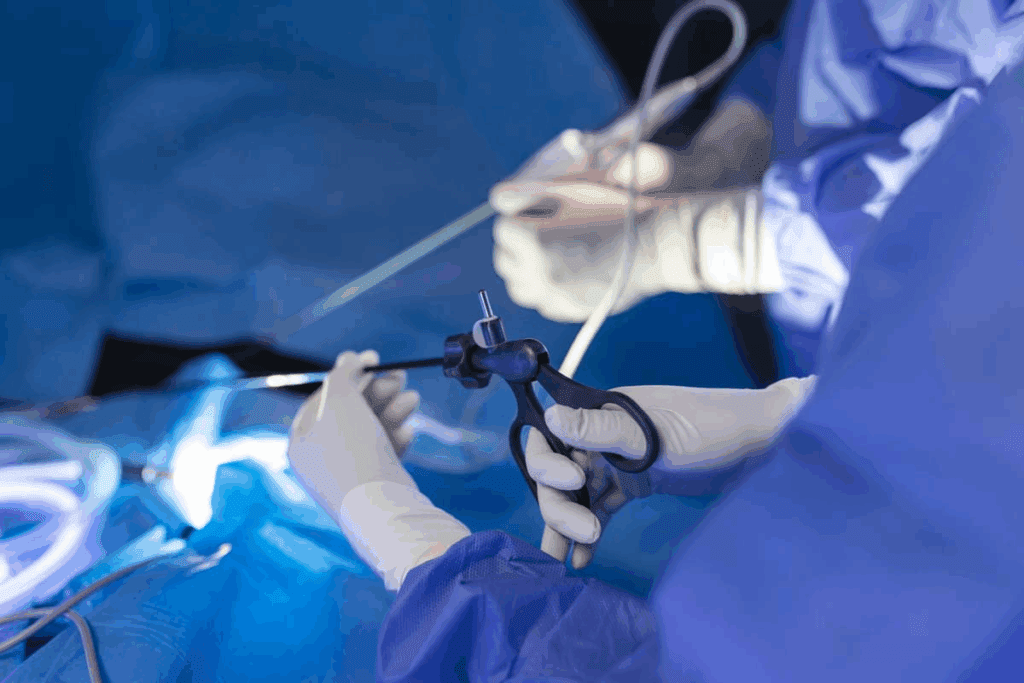Last Updated on November 26, 2025 by Bilal Hasdemir

At Liv Hospital, we focus on advanced and caring treatment for aortic aneurysms. Endovascular Aortic Aneurysm Repair (EVAR) is a new, less invasive surgery. It has changed how we treat abdominal aortic aneurysms (AAA).
EVAR repair doesn’t need a big cut in the belly. It uses small cuts in the groin to reach the aorta. This method lowers the chance of problems and helps patients heal faster. It’s great for older people or those at high risk for open surgery. EVAR uses a stent graft to safely fix AAA
Key Takeaways
- EVAR is a minimally invasive surgical technique for treating abdominal aortic aneurysms.
- Small incisions in the groin are used to access the aorta, reducing complications.
- EVAR promotes quicker recovery times compared to traditional open surgery.
- This approach is beneficial for older patients or those at high risk for open surgery.
- EVAR involves the placement of a stent graft to treat AAA.
Understanding Abdominal Aortic Aneurysms (AAA)

Abdominal aortic aneurysms (AAA) are serious and can be life-threatening. They happen when the lower part of the aorta in the abdomen gets bigger. It’s important to find and treat them quickly to avoid serious problems.
Causes of Aortic Aneurysms
Aneurysms in the abdomen are often caused by weakened aortic walls. Atherosclerosis, or plaque buildup, is a main cause. Other factors include high blood pressure, smoking, and genetics.
Risk Factors for Developing AAA
Several things can increase your chance of getting an AAA. These include:
- Age: The risk goes up after 65.
- Gender: Men are more likely to get AAA than women.
- Family History: Having a family history of AAA raises your risk.
- Smoking: Smoking damages the aortic wall.
- High Blood Pressure: It adds stress to the aortic wall.
| Risk Factor | Description | Impact on AAA Risk |
| Age | Increased risk after 65 | High |
| Gender | Men are more likely | Moderate |
| Family History | Presence of AAA in first-degree relatives | High |
Symptoms and Detection Methods
Many people with AAA don’t show symptoms until it’s serious. Some might feel pain in their abdomen or back, or notice a pulsing near their navel. It’s key to catch it early, which often means regular check-ups.
People at risk should get screened regularly. Ultrasound and CT scans are good for finding AAA early. They help doctors decide the best treatment.
The Evolution of Aortic Aneurysm Treatment

Medical technology has changed how we treat aortic aneurysms. We’ve moved from big surgeries to smaller, less invasive ones. This change has made recovery faster and outcomes better.
Traditional Open Surgical Repair
Older methods involved big cuts in the belly or chest to fix the aorta. This way was effective but tough on the body. It meant longer hospital stays and more risks, mainly for older folks or those with health issues.
Even with its downsides, open surgery was the main way to fix aortic aneurysms for years. It replaced the bad part with a fake one.
Development of Minimally Invasive Approaches
Doctors wanted to make surgery less harsh and faster. They worked on new ways to fix aortic aneurysms with smaller cuts. This meant less damage and quicker healing.
EVAR is a big step forward in treating aortic aneurysms. It uses tiny cuts in the leg to put a stent graft in the aorta. This stops the aneurysm from getting worse or bursting.
Emergence of EVAR as a Treatment Option
EVAR surgery is a game-changer for aortic aneurysm treatment. It uses small cuts in the leg to put a stent graft in the aorta. This stops the aneurysm from getting worse or bursting.
This new method cuts down on complications and hospital time. It lets people get back to their lives sooner than old methods. So, endovascular aortic aneurysm repair (EVAR) is now a top choice for many.
What Is EVAR Repair: Defining the Procedure
The EVAR procedure is a new way to treat aortic aneurysms. It’s safer than old-school surgery. We’ll dive into what it is, its parts, and what kinds of aneurysms it fixes.
The Meaning Behind the EVAR Medical Abbreviation
EVAR means EndoVascular Aneurysm Repair. It’s a method to fix an aneurysm from inside the blood vessel. The term EVAR is key in vascular surgery for treating aortic aneurysms without big surgery.
Key Components of Endovascular Aortic Aneurysm Repair
The EVAR procedure has a few main parts:
- A stent graft, which is a fabric tube with metal support.
- Catheters, for guiding the stent graft to the aneurysm.
- Imaging tech, like fluoroscopy, to see what’s happening.
Together, these parts help block blood flow to the aneurysm. This stops it from getting bigger or bursting.
Types of Aneurysms Treatable with EVAR
EVAR mainly fixes abdominal aortic aneurysms (AAAs). But, new tech has made it work for other aneurysms too. These include:
| Type of Aneurysm | Description | Treatable with EVAR |
| Abdominal Aortic Aneurysm (AAA) | An aneurysm in the abdominal aorta. | Yes |
| Thoracic Aortic Aneurysm (TAA) | An aneurysm in the thoracic aorta. | Yes, with advanced EVAR techniques |
| Iliac Aneurysm | An aneurysm in the iliac arteries. | Yes, often with AAA repair |
In short, EVAR is a big step forward in treating aortic aneurysms. It’s a less invasive option than traditional surgery. Knowing about EVAR, its parts, and uses is important for both patients and doctors.
The EVAR Surgery Procedure: Step-by-Step
Exploring the EVAR surgery procedure, we see the importance of preparation, anesthesia, and the surgery itself. EVAR is a detailed, minimally invasive surgery. It needs careful planning and execution.
Pre-Operative Preparation and Planning
Before EVAR surgery, patients go through detailed preparation and planning. They have imaging studies like CT scans and angiograms. These help the team:
- Determine if EVAR is right for the patient
- Plan the best approach for the surgery
- Choose the right stent graft size and type
Accurate pre-operative planning is key for EVAR’s success. It lets the team tailor the stent graft to the patient’s anatomy.
Anesthesia Options for EVAR
The EVAR procedure takes 2 to 3 hours. It can be done under general or regional anesthesia. The choice depends on the patient’s health, the aneurysm’s complexity, and their preference.
General anesthesia makes the patient unconscious. Regional anesthesia numbs the lower body, keeping the patient awake but pain-free. The anesthesiologist helps decide which is best.
The Surgical Process
The EVAR surgery involves several steps:
- Making small incisions in the groin to access the femoral arteries
- Inserting guidewires and catheters through the incisions to reach the aortic aneurysm
- Deploying the stent graft, guided by imaging technology like fluoroscopy
- Confirming the stent graft’s correct placement and function
- Closing the incisions
The whole process is closely watched. Imaging technology is key for precise stent graft deployment. This makes EVAR safer and more precise.
EVAR Vascular Devices and Technology
The success of EVAR repair depends a lot on new vascular devices and technology. We’ve seen big improvements in EVAR devices. These changes have made the procedure safer and more effective.
Types of Stent Grafts Used in EVAR
There are many types of stent grafts for EVAR, each for different patients. The main types are:
- Main body stent grafts
- Extension stent grafts
- Branched stent grafts
- Fenestrated stent grafts
These stent grafts are made from strong materials like polyester or PTFE. They fit well with the patient’s blood vessels.
Imaging Technologies That Guide EVAR Procedures
Imaging technologies are key in EVAR procedures. The main ones are:
- Fluoroscopy
- Angiography
- Intravascular ultrasound (IVUS)
These tools help place the stent graft accurately. This reduces risks and improves results for patients.
Recent Technological Advancements
Recently, there have been big steps forward in EVAR technology. Some key improvements are:
- Improved stent graft designs
- Advanced imaging technologies
- Enhanced delivery systems
These changes have made EVAR safer and more effective. Now, more patients can benefit from it.
As we keep innovating, we’ll see even better results for patients. Complications will likely go down too.
Benefits of EVAR Compared to Open Surgery
Endovascular Aneurysm Repair (EVAR) has changed how we treat aortic aneurysms. It offers many advantages over traditional open surgery. These benefits help improve patient outcomes.
Reduced Surgical Trauma and Blood Loss
EVAR reduces surgical trauma and blood loss. Unlike open surgery, which needs a big cut and harms a lot of tissue, EVAR uses small groin incisions. This causes less damage and helps patients heal faster.
Shorter Hospital Stays and Recovery Time
EVAR leads to shorter hospital stays and quicker recovery times. The less invasive nature of EVAR means patients can get back to their lives sooner. This improves their quality of life.
Lower Mortality Rates for High-Risk Patients
EVAR is safer for high-risk patients than open surgery, with lower death rates. This is key for those with health issues or other risks that make surgery dangerous.
Quality of Life Improvements
The benefits of EVAR go beyond the immediate recovery. It leads to long-term quality of life improvements. EVAR’s minimal impact allows patients to recover faster and more fully. They can return to their activities with less pain.
| Benefit | EVAR | Open Surgery |
| Surgical Trauma | Minimally invasive | Highly invasive |
| Hospital Stay | Shorter | Longer |
| Recovery Time | Faster | Slower |
| Mortality Rate for High-Risk Patients | Lower | Higher |
Potential Risks and Complications of EVAR Vascular Surgery
EVAR is a minimally invasive procedure, but it has its risks. It’s important to know about these risks before undergoing the surgery. Every medical procedure has its own set of possible complications.
Short-Term Complications
Short-term issues after EVAR can include bleeding, graft migration, or vessel injury. These problems are rare but serious. They might need quick medical care. Close monitoring after surgery is key to catch and treat these problems fast.
Long-Term Concerns
Long-term issues with EVAR include endoleaks, graft failure, and the need for ongoing checks. Patients need regular follow-up to ensure the stent graft works right and the aneurysm doesn’t grow.
Endoleaks: A Unique EVAR Complication
Endoleaks are a special problem with EVAR. They happen when blood leaks into the aneurysm sac, even with a stent graft. This can put pressure on the aneurysm and might cause it to rupture. The type and severity of endoleaks determine how they are treated.
Reintervention Rates
Reintervention after EVAR is a big concern. The rate of needing more surgery depends on the aneurysm size, graft type, and patient’s body. Regular surveillance helps catch problems early, which can improve long-term results.
Knowing about these risks and complications is essential for those thinking about EVAR. It helps them make informed choices and shows why follow-up care is so important in managing these risks.
Patient Selection: Who Is a Candidate for EVAR Procedure?
Choosing the right patient for EVAR is a detailed process. We look at many factors to make sure EVAR is safe and effective for each person. This careful selection helps avoid risks and ensures the best results.
Anatomical Considerations
The shape and size of the aortic aneurysm are key in deciding if EVAR is right. We check the aneurysm’s size, shape, and where it is. We also look at the blood vessels around it.
“The shape of the patient’s blood vessels is very important for EVAR success,” say vascular surgeons. Using CT scans, we check if EVAR is possible.
Age and Comorbidity Factors
We also consider the patient’s age and health when choosing EVAR. Older patients or those with health issues might find EVAR easier than traditional surgery.
- Advanced age
- Presence of comorbid conditions
- Previous surgical history
We balance these factors to find the best treatment for each patient.
Contraindications for EVAR
Even with its benefits, EVAR isn’t for everyone. Some reasons include bad access vessels or aneurysm shapes that don’t fit EVAR. Certain health conditions also make EVAR not suitable.
“Choosing the right patients for EVAR is critical to its success and safety.”
We do a detailed check to find out if EVAR is right for each patient.
Advanced EVAR Techniques for Complex Aneurysms
Advanced EVAR techniques have changed how we treat complex aneurysms. These aneurysms are hard to treat because they’re close to important blood vessels. But, new tech and methods let us tailor treatments for these tough cases.
Fenestrated EVAR (FEVAR)
Fenestrated EVAR is a big step forward for treating complex aortic aneurysms. It uses special stent grafts with holes that match the patient’s blood vessels. This keeps blood flowing to important organs while fixing the aneurysm.
Creating these stent grafts needs careful planning and precise work. We use advanced imaging to get the exact details of the aneurysm and its blood vessels. Then, we make a stent graft that fits perfectly, ensuring the best results.
Branched EVAR Devices
Branched EVAR devices go beyond FEVAR by adding direct paths for blood to flow to important vessels. They’re great for aneurysms that affect longer parts of the aorta or have many branches. This helps keep blood flowing to organs while fixing the aneurysm.
Creating and using these devices requires a lot of skill and knowledge of the patient’s body. Our team works together to plan and do these complex surgeries, aiming for the best results for our patients.
EVAR for Ruptured Abdominal Aortic Aneurysms
EVAR for ruptured abdominal aortic aneurysms (rAAAs) is a big step forward in emergency vascular surgery. Old methods for fixing rAAAs are risky, but EVAR is quicker and less stressful. It’s a safer option for patients in emergency situations.
Even though EVAR for rAAAs has its challenges, like making quick decisions, it’s better than traditional surgery. We have fast ways to find out if EVAR is right for a patient in an emergency. This means we can act fast to help them.
Clinical Outcomes and Success Rates of EVAR
Understanding EVAR’s success in treating aortic aneurysms is key. We look at what makes EVAR effective, from immediate results to long-term health.
Short-Term vs. Long-Term Success Rates
EVAR’s success is seen in both short and long terms. Short-term success means no major problems or deaths right after the surgery. Long-term success is about how well the repair lasts and if the patient survives.
Research shows EVAR works well in the short term. For example, a study in the Journal of Vascular Surgery found fewer deaths and complications with EVAR than with open surgery.
Comparative Studies: EVAR vs. Open Repair
Studies compare EVAR to open surgery. They show EVAR is safer and less risky in the first few weeks after surgery.
| Outcome Measure | EVAR | Open Repair |
| 30-Day Mortality Rate | 1.2% | 3.5% |
| Complication Rate | 10% | 25% |
| Hospital Stay | 2-3 days | 7-10 days |
Quality of Life After EVAR
EVAR improves life for those with aortic aneurysms. It’s less invasive, leading to quicker recovery and less pain.
A study in the Journal of Endovascular Therapy showed big improvements in patients’ quality of life after EVAR.
Cost-Effectiveness Considerations
EVAR’s cost is a big factor. It might cost more upfront, but it’s more cost-effective in the long run. This is because it leads to shorter hospital stays and fewer complications.
A study in the Journal of Vascular Surgery found EVAR is a cost-effective choice, mainly for those at high risk with open surgery.
Conclusion: The Future of EVAR Aortic Aneurysm Repair
The future of EVAR aortic aneurysm repair looks bright. New advancements in EVAR technology and techniques are on the horizon. These will likely improve outcomes for patients with abdominal aortic aneurysms.
Research has shown EVAR to be a safe and effective treatment. It has a low death rate of 1.8% and high success rates at 5 and 9 years. This is according to a study on PubMed Central.
Future improvements in stent grafts, imaging, and procedures are expected. These advancements will make EVAR safer, more effective, and easier to access. This will help more people get the treatment they need.
FAQ
What is EVAR repair?
EVAR stands for EndoVascular Aneurysm Repair. It’s a new way to fix big blood vessel problems in the belly. Doctors use tiny cuts in the groin to put in a stent graft.
How does EVAR compare to open surgery?
EVAR is less invasive than open surgery. It causes less damage and blood loss. Patients usually stay in the hospital less time and recover faster.
This makes EVAR a good choice for older patients or those at high risk for open surgery.
What are the causes and risk factors of abdominal aortic aneurysms?
AAA can be caused by atherosclerosis, high blood pressure, and smoking. Genetics also play a part. Age, gender, and family history are risk factors too.
What are the symptoms of abdominal aortic aneurysms?
Many people with AAA don’t show symptoms. But some might feel pain in the belly or back. They might also feel a pulsing near the navel.This shows why regular check-ups and screenings are key.
How is EVAR performed?
The EVAR procedure starts with getting ready and planning. Then, a stent graft is put in through small cuts in the groin. Imaging guides the process.
What are the benefits of EVAR?
EVAR has many benefits. It causes less damage and blood loss. Patients stay in the hospital less and recover faster.This leads to lower death rates for high-risk patients and better quality of life.
What are the risks and complications of EVAR?
EVAR is mostly safe, but risks exist. Short-term problems like bleeding or graft migration can happen. Long-term issues like endoleaks need watching and might need more surgery.
Who is a candidate for EVAR?
Choosing who gets EVAR involves looking at the aneurysm’s size and shape. Age and other health issues are also considered.This helps decide if EVAR is right for the patient.
Can EVAR be used for complex aneurysms?
Yes, EVAR can treat complex aneurysms. New techniques like fenestrated EVAR and branched EVAR devices help with cases that were once too hard for standard EVAR.
What are the clinical outcomes and success rates of EVAR?
EVAR’s success is measured in short-term and long-term results. These include death rates, complication rates, and the need for more surgery.Studies show EVAR is as good as open repair in these areas.
Is EVAR cost-effective?
EVAR is cost-effective in the long run. It saves on hospital stays and recovery time. It also improves patients’ quality of life.
References:
- Wyss, T. R., & Bonati, L. H. (2023). Imaging, planning, and procedural considerations for endovascular repair of abdominal aortic aneurysms. Nature Reviews Cardiology, 20(6), 351-363. Retrieved fromhttps://www.nature.com/articles/s41569-023-00884-5






